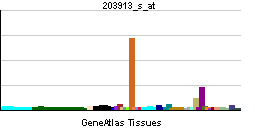HPGD
| Hydroxyprostaglandin dehydrogenase 15-(NAD) | |||||||||||||
|---|---|---|---|---|---|---|---|---|---|---|---|---|---|
 PDB rendering based on 2gdz. | |||||||||||||
| |||||||||||||
| Identifiers | |||||||||||||
| Symbols | HPGD ; 15-PGDH; PGDH; PGDH1 | ||||||||||||
| External IDs | Template:OMIM5 Template:MGI HomoloGene: 68095 | ||||||||||||
| |||||||||||||
| RNA expression pattern | |||||||||||||
 | |||||||||||||
 | |||||||||||||
 | |||||||||||||
| More reference expression data | |||||||||||||
| Orthologs | |||||||||||||
| Template:GNF Ortholog box | |||||||||||||
| Species | Human | Mouse | |||||||||||
| Entrez | n/a | n/a | |||||||||||
| Ensembl | n/a | n/a | |||||||||||
| UniProt | n/a | n/a | |||||||||||
| RefSeq (mRNA) | n/a | n/a | |||||||||||
| RefSeq (protein) | n/a | n/a | |||||||||||
| Location (UCSC) | n/a | n/a | |||||||||||
| PubMed search | n/a | n/a | |||||||||||
Hydroxyprostaglandin dehydrogenase 15-(NAD), also known as HPGD, is a human gene.[1]
References
Further reading
- Erwich JJ, Keirse MJ (1992). "Placental localization of 15-hydroxy-prostaglandin dehydrogenase in early and term human pregnancy". Placenta. 13 (3): 223–9. PMID 1635910.
- Ensor CM, Yang JY, Okita RT, Tai HH (1990). "Cloning and sequence analysis of the cDNA for human placental NAD(+)-dependent 15-hydroxyprostaglandin dehydrogenase". J. Biol. Chem. 265 (25): 14888–91. PMID 1697582.
- Ensor CM, Tai HH (1991). "Site-directed mutagenesis of the conserved tyrosine 151 of human placental NAD(+)-dependent 15-hydroxyprostaglandin dehydrogenase yields a catalytically inactive enzyme". Biochem. Biophys. Res. Commun. 176 (2): 840–5. PMID 2025296.
- Krook M, Marekov L, Jörnvall H (1990). "Purification and structural characterization of placental NAD(+)-linked 15-hydroxyprostaglandin dehydrogenase. The primary structure reveals the enzyme to belong to the short-chain alcohol dehydrogenase family". Biochemistry. 29 (3): 738–43. PMID 2337593.
- Pichaud F, Frendo JL, Delage-Mourroux R; et al. (1995). "Sequence of a novel mRNA coding for a C-terminal-truncated form of human NAD(+)-dependent 15-hydroxyprostaglandin dehydrogenase". Gene. 162 (2): 319–22. PMID 7557451.
- Sangha RK, Walton JC, Ensor CM; et al. (1994). "Immunohistochemical localization, messenger ribonucleic acid abundance, and activity of 15-hydroxyprostaglandin dehydrogenase in placenta and fetal membranes during term and preterm labor". J. Clin. Endocrinol. Metab. 78 (4): 982–9. PMID 8157731.
- Krook M, Ghosh D, Duax W, Jörnvall H (1993). "Three-dimensional model of NAD(+)-dependent 15-hydroxyprostaglandin dehydrogenase and relationships to the NADP(+)-dependent enzyme (carbonyl reductase)". FEBS Lett. 322 (2): 139–42. PMID 8482380.
- Pichaud F, Delage-Mourroux R, Pidoux E; et al. (1997). "Chromosomal localization of the type-I 15-PGDH gene to 4q34-q35". Hum. Genet. 99 (2): 279–81. PMID 9048936.
- Delage-Mourroux R, Pichaud F, Frendo JL; et al. (1997). "Cloning and sequencing of a new 15-hydroxyprostaglandin dehydrogenase related mRNA". Gene. 188 (1): 143–8. PMID 9099873.
- Patel FA, Clifton VL, Chwalisz K, Challis JR (1999). "Steroid regulation of prostaglandin dehydrogenase activity and expression in human term placenta and chorio-decidua in relation to labor". J. Clin. Endocrinol. Metab. 84 (1): 291–9. PMID 9920098.
- Zhou H, Tai HH (1999). "Threonine 188 is critical for interaction with NAD+ in human NAD+-dependent 15-hydroxyprostaglandin dehydrogenase". Biochem. Biophys. Res. Commun. 257 (2): 414–7. doi:10.1006/bbrc.1999.0356. PMID 10198228.
- Greenland KJ, Jantke I, Jenatschke S; et al. (2000). "The human NAD+-dependent 15-hydroxyprostaglandin dehydrogenase gene promoter is controlled by Ets and activating protein-1 transcription factors and progesterone". Endocrinology. 141 (2): 581–97. PMID 10650939.
- Conner CE, Kelly RW, Hume R (2001). "Regulation of prostaglandin availability in human fetal lung by differential localisation of prostaglandin H synthase-1 and prostaglandin dehydrogenase". Histochem. Cell Biol. 116 (4): 313–9. doi:10.1007/s004180100323. PMID 11702189.
- Giannoulias D, Patel FA, Holloway AC; et al. (2002). "Differential changes in 15-hydroxyprostaglandin dehydrogenase and prostaglandin H synthase (types I and II) in human pregnant myometrium". J. Clin. Endocrinol. Metab. 87 (3): 1345–52. PMID 11889207.
- Cho H, Tai HH (2003). "Threonine 11 of human NAD(+)-dependent 15-hydroxyprostaglandin dehydrogenase may interact with NAD(+) during catalysis". Prostaglandins Leukot. Essent. Fatty Acids. 66 (5–6): 505–9. PMID 12144871.
- Strausberg RL, Feingold EA, Grouse LH; et al. (2003). "Generation and initial analysis of more than 15,000 full-length human and mouse cDNA sequences". Proc. Natl. Acad. Sci. U.S.A. 99 (26): 16899–903. doi:10.1073/pnas.242603899. PMID 12477932.
- Tai HH, Ensor CM, Zhou H, Yan F (2003). "Structure and function of human NAD(+)-linked 15-hydroxyprostaglandin dehydrogenase". Adv. Exp. Med. Biol. 507: 245–50. PMID 12664592.
- McKeown KJ, Challis JR (2003). "Regulation of 15-hydroxy prostaglandin dehydrogenase by corticotrophin-releasing hormone through a calcium-dependent pathway in human chorion trophoblast cells". J. Clin. Endocrinol. Metab. 88 (4): 1737–41. PMID 12679466.
- Patel FA, Funder JW, Challis JR (2003). "Mechanism of cortisol/progesterone antagonism in the regulation of 15-hydroxyprostaglandin dehydrogenase activity and messenger ribonucleic acid levels in human chorion and placental trophoblast cells at term". J. Clin. Endocrinol. Metab. 88 (6): 2922–33. PMID 12788907.
- Nandy A, Jenatschke S, Hartung B; et al. (2004). "Genomic structure and transcriptional regulation of the human NAD+-dependent 15-hydroxyprostaglandin dehydrogenase gene". J. Mol. Endocrinol. 31 (1): 105–21. PMID 12914529.
| This protein-related article is a stub. You can help Wikipedia by expanding it. |